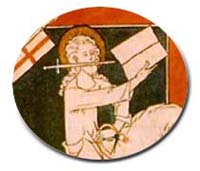 |
Forgotten Truths
Catholics Should & Must
Venerate the Relics of Saints
Catholics of the past looked upon holy relics as their greatest riches, the treasure of their churches in their villages or cities. The presence of relics the Saints was a source of miracles for the people, a terror to the legions of Hell, a check to hostile armies.
Thus did the relics serve to guard morals, foster faith, and encourage prayer. Their very presence attracted as great as crowds as now flock to our centers of pleasure.
Sadly, the heretics of the 16th century profaned the tombs of the Saints, ridiculing and even destroying their relics. In response to these deformers misnamed “reformers,” the Council of Trent
and its Roman Catechism express the unanimous testimony of Tradition, setting forth the theological reasons for the honor paid by the Church to the relics of Saints:
The Council of Trent
“The holy Synod enjoins on all bishops and others who sustain the office and charge of teaching that … they instruct the faithful diligently concerning the intercession and invocation of saints; the honor paid to relics; and the legitimate use of images. Let them teach the faithful that since the Saints reign together with Christ and offer up their own prayers to God for men, it is good and useful suppliantly to invoke them, and to have recourse to their prayers, aid and help for obtaining benefits from God, through His Son, Jesus Christ Our Lord, Our Redeemer and Savior.
They think impiously, those who deny that … that the holy bodies of the holy martyrs and of others now living with Christ – whose bodies were the living members of Christ and the temple of the Holy Ghost, and which are by Him to be raised unto eternal life, and to be glorified – are to be venerated by the faithful. For through those bodies many benefits are bestowed by God on men.
So that they who affirm that veneration and honor are not due to the relics of Saints … are uselessly honored by the faithful; and that the places dedicated to the memories of the Saints are in vain visited with the view of obtaining their aid; are wholly to be condemned, as the Church has already long since condemned, and now also condemns them.
The Roman Catechsim
From all this we may conclude that to honor the Saints who have slept in the Lord, to invoke them, and to venerate their sacred relics and ashes, far from diminishing, tends considerably to increase the glory of God, in proportion as man’s hope is thus animated and fortified, and he himself encouraged to imitate the Saints.
This is a practice which is also supported by the authority of the Second Council of Nice, the Councils of Gangra and of Trent, and by the testimony of the Fathers.
In order, however, that the pastor may be the better prepared to meet the objections of those who deny this doctrine, he should consult particularly St. Jerome against Vigilantius, and St. Damascene. To the teaching of these Fathers should be added as a consideration of prime importance that the practice was received from the Apostles, and has always been retained and preserved in the Church of God. ...
A stronger claim which the Saints have to be honored and invoked is that they constantly pray for our salvation and obtain for us by their merits and influence many blessings from God. If there is joy in Heaven over the conversion of one sinner, will not the citizens of Heaven assist those who repent? When they are invoked, will they not obtain for us the pardon of sins, and the grace of God ?
The Honor & Invocation of Saints Is Confirmed by Miracles
But who would not be convinced of the honor due the Saints and of the help they give us by the wonders wrought at their tombs? Diseased eyes, hands and other members are restored to health; the dead are raised to life, and demons are expelled from the bodies of men! These are facts which St. Ambrose and St. Augustine, most unexceptionable witnesses, declare in their writings, not that they heard, as many did, nor that they read, as did men – very reliable men, but that they saw.
But why multiply proofs? If the clothes, the handkerchiefs, and even the very shadows of the Saints, while yet on earth, banished disease and restored health, who will have the hardihood to deny that God can still work the same wonders by the holy ashes, the bones and other relics of the Saints?
Of this we have a proof in the restoration to life of the dead body which was accidentally let down into the grave of Eliseus, and which, on touching the body (of the Prophet), was instantly restored to life.




Related Topics of Interest
 Feast of the Holy Relics - November 5 Feast of the Holy Relics - November 5
 St. Helena, August 18 St. Helena, August 18
 St. Benedict the Moor – April 4 St. Benedict the Moor – April 4
 Holy Thorn of Andria & Fr. Margil Holy Thorn of Andria & Fr. Margil
 The Eucharistic Miracle of Lanciano The Eucharistic Miracle of Lanciano
 The Holy Miracle of Santarem The Holy Miracle of Santarem
 Abolished to Please Protestants: Abolished to Please Protestants:
The Finding of the Holy Cross Feast

Related Works of Interest
|
Forgotten Truths | Religious | Home | Books | CDs | Search | Contact Us | Donate

© 2002-
Tradition in Action, Inc. All Rights Reserved
|
 |
|